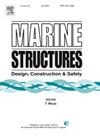低速冰楔冲击下矩形泡沫芯夹芯板的理论研究
IF 5.1
2区 工程技术
Q1 ENGINEERING, CIVIL
引用次数: 0
摘要
本文建立了矩形泡沫芯夹层板在低速冰楔冲击下的冲击响应理论模型。利用冰楔的压力-面积(P-A)关系和泡沫芯夹层截面的屈服准则,分别求解了冰破碎耗能和结构塑性变形耗能。基于冰冲击响应的共享能量耗散机制和迭代解,推导了矩形泡沫芯夹层板在冰楔低速冲击下的塑性变形和能量耗散特性。将解析预测结果与数值和实验结果进行了比较,验证了理论模型的准确性。此外,还研究了冲击位置、冰楔厚度以及长径比对低速冰楔冲击下矩形泡沫芯夹层板动力响应的影响。结果表明,塑性变形和破冰能的解析预测与数值和实验结果吻合较好。为矩形泡沫芯夹芯板在冰冲击下的结构设计和安全性分析提供了重要的指导。本文章由计算机程序翻译,如有差异,请以英文原文为准。
Theoretical study of rectangular foam core sandwich plate under low velocity ice wedge impact
In this study, a theoretical model is developed to investigate the impact response of rectangular foam-core sandwich plates subjected to low velocity ice wedge impacts. By employing the pressure-area (P-A) relationship of ice wedge and the yield criterion for foam-core sandwich cross-sections, the ice fragmentation energy dissipation and structural plastic deformation energy dissipation are respectively solved. Based on the shared-energy dissipation mechanism and iterative solution of ice impact response, the plastic deformation and energy dissipation characteristics of rectangular foam core sandwich plates under low velocity ice wedge impact are derived. The analytical predictions are compared with the numerical and experimental results to verify the accuracy of theoretical model. Besides, the effects of impact positions and ice wedge thickness as well as aspect ratio on dynamic response of rectangular foam core sandwich plate under low velocity ice wedge impact are studied. Results demonstrate that the analytical predictions for plastic deformation and ice fragmentation energy agree well with numerical and experimental results. This work provides an important guidance for the structural design and safety analysis of rectangular foam core sandwich plate under ice impact.
求助全文
通过发布文献求助,成功后即可免费获取论文全文。
去求助
来源期刊

Marine Structures
工程技术-工程:海洋
CiteScore
8.70
自引率
7.70%
发文量
157
审稿时长
6.4 months
期刊介绍:
This journal aims to provide a medium for presentation and discussion of the latest developments in research, design, fabrication and in-service experience relating to marine structures, i.e., all structures of steel, concrete, light alloy or composite construction having an interface with the sea, including ships, fixed and mobile offshore platforms, submarine and submersibles, pipelines, subsea systems for shallow and deep ocean operations and coastal structures such as piers.
 求助内容:
求助内容: 应助结果提醒方式:
应助结果提醒方式:


